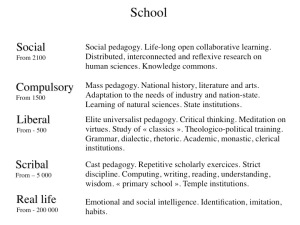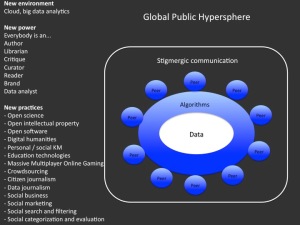We will first make a detour by the history of knowledge and communication in order to understand what are the current priorities in education.
THE EVOLUTION OF KNOWLEDGE

The above slide describes the successive steps in the augmentation of symbolic manipulation. At each step in the history of symbolic manipulation, a new kind of knowledge unfolds. During the longest part of human history, the knowledge was only embedded in narratives, rituals and material tools.
The first revolution is the invention of writing with symbols endowed with the ability of self-conservation. This leads to a remarquable augmentation of social memory and to the emergence of new forms of knowledge. Ideas were reified on an external surface, which is an important condition for critical thinking. A new kind of systematic knowledge was developed: hermeneutics, astronomy, medicine, architecture (including geometry), etc.
The second revolution optimizes the manipulation of symbols like the invention of the alphabet (phenician, hebrew, greek, roman, arab, cyrilic, korean, etc.), the chinese rational ideographies, the indian numeration system by position with a zero, paper and the early printing techniques of China and Korea. The literate culture based on the alphabet (or rational ideographies) developed critical thinking further and gave birth to philosophy. At this stage, scholars attempted to deduce knowledge from observation and deduction from first principles. There was a deliberate effort to reach universality, particularly in mathematics, physics and cosmology.
The third revolution is the mecanization and the industrialization of the reproduction and diffusion of symbols, like the printing press, disks, movies, radio, TV, etc. This revolution supported the emergence of the modern world, with its nation states, industries and its experimental mathematized natural sciences. It was only in the typographic culture, from the 16th century, that natural sciences took the shape that we currently enjoy: systematic observation or experimentation and theories based on mathematical modeling. From the decomposition of theology and philosophy emerged the contemporary humanities and social sciences. But at this stage human science was still fragmented by disciplines and incompatible theories. Moreover, its theories were rarely mathematized or testable.
We are now at the beginning of a fourth revolution where an ubiquitous and interconnected infosphere is filled with symbols – i.e. data – of all kinds (music, voice, images, texts, programs, etc.) that are being automatically transformed. With the democratization of big data analysis, the next generations will see the advent of a new scientific revolution… but this time it will be in the humanities and social sciences. The new human science will be based on the wealth of data produced by human communities and a growing computation power. This will lead to reflexive collective intelligence, where people will appropriate (big) data analysis and where subjects and objects of knowledge will be the human communities themselves.
THE EVOLUTION OF EDUCATION

We have seen that for each revolution in symbolic manipulation, there was some new developements of knowledge. The same can be said of learning methods and institutions. The school was invented by the scribes. At the beginning, it was a professional training for a caste of writing specialists: scribes and priests. Pedagogy was strict and repetitive. Our current primary school is reminiscent of this first learning institution.
Emerging in the literate culture, the liberal education was aimed at broader elites than the first scribal schools. Young people were trained in reading and interpreting the « classics ». They learned how to build rational argumentation and persuasive discourses.
In modern times, education became compulsory for every citizen of the nation state. Learning became industrialized and uniform through state programs and institutions.
At the time of the algorithmic medium, knowledge is evolving very fast, almost all learning resources are available for free and we interact in social media. This is the end of the old model of learning communities organizing themselves around a library or any physical knowledge repository. Current learning should be conceived as delocalized, life-long and collaborative. The whole society will get a learning dimension. But that does not mean that traditional learning institutions for young people are no longer relevant. Just the opposite, because young people should be prepared for collaborative learning in social media using a practically infinite knowledge repository without any transcending guiding authority. They will need not only technical skills (that will evolve and become obsolete very quickly) but above all moral and intellectual skills that will empower them in their life-long discovery travels.
DATA CURATION SKILLS AT THE CORE OF THE NEW LITERACY

In the algorithmic medium, communication becomes a collaboration between peers to create, categorize, criticize, organize, read, promote and analyse data by the way of algorithmic tools. It is a stigmergic communication because, even if people dialogue and talk to each other, the main channel of communication is the common memory itself, a memory that everybody transforms and exploits. The above slide lists some examples of this new communication practices. Data curation skills are at the core of the new algorithmic literacy.

I present in the above slide the fundamental intellectual and moral skills that every student will have to master in order to survive in the algorithmic culture. The slide is organized by three rows and three columns that work in an interdependant manner. As the reader can see, personal intelligence is not independant form collective intelligence and vice versa. Moreover, both of them need critical intelligence!
PERSONAL INTELLIGENCE
Attention management is not only about focusing or avoiding distraction. It is also about choosing what we want or need to learn and being able to select the relevant sources. We decide what is relevant or not according to our own priorities and our criteria for trust. By the way, people and institutions are the real sources to be trusted or not, not the platforms!
Interpretation. Even with the statistical tools of big data analysis, we will always need theories and causal hypothesis, and not only correlations. We want to understand something and act upon this understanding. Having intuitions and theories derived from our knowledge of a domain, we can use data analytics to test our hypothesis. Asking the right questions to the data is not trivial!
Memory management. The data that we gather must be managed at the material level: we must choose the right memory tool in the clouds. But the data must also be managed at the conceptual level: we have to create and maintain a useful categorisation system (tags, ontologies…) in order to retrieve and analyse easily the desired information.
CRITICAL INTELLIGENCE
External critique. There is no transcendant authority in the new communication space. If we don’t want to be fooled, we need to diversify our sources. This means that we will gather sources that have diverse theories and point of views. Then, we should act on this diversity by cross-examining the data and observe where they contradict and where they confirm each other.
Internal critique. In order to understand who is a source, we must identify its classification system, its categories and its narrative. In a way, the source is its narrative.
Pragmatic critique. In essence, the pragmatic critique is the most devastating because it is at this point that we compare the narrative of the source and what it is effectively doing. We can do this by checking the actions of one source as reported by other sources. We can also notice the contradictions in the source’s narratives or a discrepancy between its official narrative and the pragmatic effects of its discourses. A source cannot be trusted when it is not transparent about its references, agenda, finance, etc.
COLLECTIVE INTELLIGENCE
The collective intelligence that I am speaking about is not a miracle solution but a goal to reach. It emerges in the new algorithmic environment in interaction with personal and critical intelligence .
Stigmergic communication. Stigmergy means that people communicate by modifying a common memory. We should distinguish between the local and the global memory. In the local memory (particular communities or networks), we should pay attention to singular contexts and histories. We should also avoid ignorance of other’s contributions, non-relevant questions, trolling, etc.
Liberty. Liberty is a dialectic of power and responsability. Our power here is our ability to create, assess, organize, read and analyse data. Every act in the algorithmic medium re-organizes the common memory: reading, tagging, buying, posting, linking, liking, subscribing, etc. We create collaboratively our own common environment. So we need to take responsability of our actions.
Collaborative learning. This is the main goal of collective intelligence and data curation skills in general. People add explicit knowledge to the common memory. They express what they have learnt in particular contexts (tacit knowledge) into clear and decontextualized propositions, or narratives, or visuals, etc. They translate into common software or other easily accessible resources (explicit) the skills and knowledge that they have internalized in their personal reflexes through their experience (tacit). Symetrically, people try to apply whatever usefull resources they have found in the common memory (explicit) and to acquire or integrate it into their reflexes (tacit).

The final slide above is a visual explicitation of the collaborative learning process. Peers working in a common field of practice use their personal intelligence (PI) to transform tacit knowledge into explicit knowledge. They also work in order to translate some common explicit knowledge into their own practical knowledge. In the algorithmic medium, the explicit knowledge takes the form of a common memory: data categorized and evaluated by the community. The whole process of transforming tacit knowledge into explicit knowledge and vice versa takes place largely in social media, thank to a civilized creative conversation. Intellectual and social (or moral) skills work together!
[…] 2015. I gave four speeches in front of different audiences: one of my main speeches was about « collective intelligence for educators » and another about « The emergence of reflexive collective intelligence ». I had several […]
LikeLike
[…] Levy's Blog Various thoughts and papers in french and english « Collective Intelligence for Educators Education and Technology: Notes on my Trip to Buenos-Aires […]
LikeLike
klepnÃâte na následujÃÂcàwebovou stránku
Collective Intelligence for Educators | Pierre Levy’s Blog
LikeLike
collective intelligence is very useful for us to find a better solution.
LikeLike
I’d like to know if you have defined some metric in relation to explicit knowledge acquisition?. I’m agree with the ideas generated in this article but i’d like applying the concepts into a empirical study using my own ICT tool. I’ll be so glad with your answer.
LikeLike
I have no metrics
LikeLike
[…] et de création originale. Un des grands défis de l’enseignement contemporain consiste à éduquer les étudiants à une utilisation responsable des nouveaux outils de communication. Apprendre à gérer son attention, faire une analyse critique des sources auxquelles on se […]
LikeLike
[…] but at this point, I’m just interested in getting a conversation started and building on the collective intelligence of music education folks who address technology in their programs. Specifically, I’m […]
LikeLike
I love the logical cleanliness of the presentation.
LikeLike
Can you share with me the context write-up for your quote (snippet of Collective Intelligence)
“Individuals tolerate, less and less, uniform or rigid courses that do not correspond
to their real needs and to the specificity of their chosen path through life.” I couldn’t find the right text from the contributions for educators/formators. I am currently working on UCB-Brazil course on Cooperating Learning (in higher education) for formative education.
LikeLike
[…] them [2]. And we know from experience that children are not the only gullible subjects. Ideally, the new critical thinking education should teach future citizens to organize themselves as small, autonomous intelligence agencies that […]
LikeLike